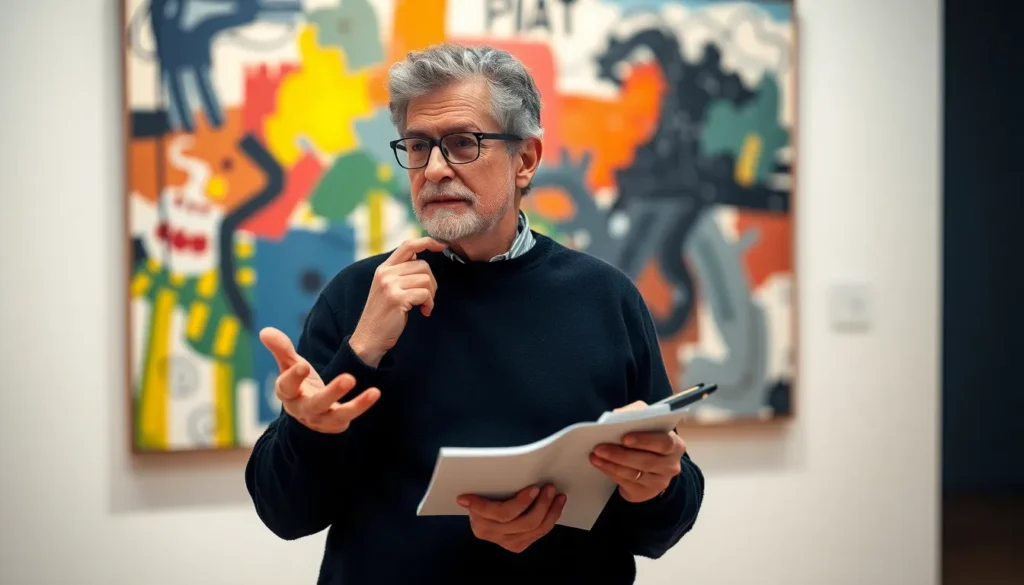Table of Contents
ToggleArt isn’t just paint on a canvas; it’s a conversation waiting to happen. Whether you’re a seasoned critic or a curious novice, understanding the nuances of art criticism can transform how you experience and appreciate creativity. Why settle for a simple “I like it” when you can dive deep into the layers of meaning, technique, and emotion?
Understanding Art Criticism
Art criticism involves analyzing and evaluating various aspects of art, including technique, form, context, and meaning. Through this analysis, critics provide insights that enhance viewers’ understanding and appreciation.
Definition of Art Criticism
Art criticism represents the study and assessment of visual art. It encompasses interpretations grounded in research and personal insight. Critics examine elements such as composition, color, and historical context, guiding viewers in understanding the artist’s intentions. Various methodologies exist, each providing a unique perspective on the artwork’s value. Critics articulate these perspectives through written articles, critiques, or verbal discussions.
Importance in the Art World
In the art world, criticism plays a pivotal role in shaping public perception of artworks. It fosters insightful dialogue between artists and audiences, facilitating deeper connections. Well-developed criticism influences trends, encouraging emerging artists and informing collectors’ choices. Critics challenge the status quo and stimulate discourse on cultural and social contexts. This exchange enriches the art community, ultimately enhancing collective appreciation and understanding of diverse artistic expressions.
Key Elements of Art Criticism

Art criticism involves several key elements that guide the analysis and evaluation of artwork. Understanding these elements enhances engagement and appreciation for art.
Description
Description focuses on the visual and physical characteristics of an artwork. Elements such as composition, color palette, and medium provide essential information about the piece. Critics highlight significant features that draw the viewer’s attention. For instance, the use of contrasting colors can create a dynamic visual impact. Furthermore, exploring details like texture and scale helps establish a baseline for deeper analysis. Descriptive aspects serve as the foundation upon which further interpretation and judgment can occur.
Interpretation
Interpretation reflects the meanings and contexts behind an artwork. Critics analyze the themes, symbols, and historical references present in the piece. For example, a landscape painting might evoke feelings of tranquility or explore environmental concerns. Understanding the artist’s background and intentions often informs these interpretations. Critiques of artwork also incorporate perspectives from different cultural contexts. Various methodologies contribute to a richer comprehension of the artwork’s significance and how it resonates with audiences.
Judgment
Judgment involves assessing the quality and impact of the artwork. This evaluation takes into account both subjective and objective criteria. Critics consider elements such as emotional resonance and technical skill. Art that challenges conventions often generates significant discussion. Moreover, judgments can also reflect how effectively the artist communicates their message. Critics articulate their opinions on the strengths and weaknesses of the piece, informing the broader conversation around art’s significance and value in society.
Methods of Art Criticism
Art criticism employs various methods to analyze and evaluate artworks effectively. Two prominent approaches are formal analysis and contextual analysis, each providing unique insights.
Formal Analysis
Formal analysis evaluates art based on visual elements and design principles. Critics focus on aspects like composition, color, line, texture, and space. They examine how these elements interact within the artwork, influencing the viewing experience. By assessing balance, harmony, unity, and contrast, critics reveal how artists convey meaning through structure. This method invites viewers to appreciate artistic decisions, drawing connections between visual components and the overall impact of the piece.
Contextual Analysis
Contextual analysis situates artwork within broader historical, cultural, and social frameworks. Critics consider the artist’s background, historical events, and cultural movements that inform the artwork’s creation. This perspective emphasizes the significance of context in interpreting meaning and understanding themes. By exploring societal influences and the artist’s intentions, contextual analysis enriches appreciation for art, highlighting connections to contemporary issues and personal narratives. This method deepens the dialogue between the artwork and its audience, fostering a comprehensive understanding of its relevance.
Writing Your Own Art Criticism
Art criticism provides an opportunity to engage deeply with artworks. Crafting your own criticism requires a structured approach and thoughtful techniques.
Structuring Your Review
Begin by describing the artwork with clarity, focusing on visual details such as colors, forms, and lines. Next, interpret the meaning by linking themes and emotions to specific elements within the piece. After that, provide a judgment based on its impact, significance, and the artist’s intentions. End the review with personal reflections to invite readers into your perspective. This structure ensures a comprehensive analysis that connects descriptive, interpretative, and evaluative elements seamlessly.
Tips for Effective Criticism
Focus on clarity when writing, avoiding overly complicated terminology that may alienate readers. Engage with the artwork on a personal level, allowing genuine reactions to inform the criticism. Use specific examples from the piece to illustrate points, ensuring arguments remain grounded in observable details. Embrace different viewpoints to enrich the analysis, blending both personal insights and scholarly perspectives. Finally, keep the audience in mind, ensuring the criticism resonates with both novices and seasoned art lovers alike.
Engaging with art criticism opens doors to a richer understanding of visual art. By exploring the various elements and methods of critique, individuals can connect more deeply with artworks. This practice not only enhances personal appreciation but also fosters meaningful conversations within the art community.
As readers embark on their journey through art criticism, they’ll find that each analysis offers unique insights. Embracing diverse perspectives enriches the dialogue and encourages a broader exploration of cultural and social contexts. Ultimately, art criticism serves as a vital tool for both artists and audiences, bridging gaps and nurturing a deeper appreciation for the art that surrounds them.



